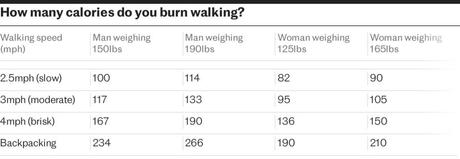
According to the British Heart Foundation, the average person is sedentary for about 9.5 hours a day. This prolonged amount of inactivity can weaken muscles and bones and affect our body's ability to regulate blood sugar levels and metabolize fat - all of which can lead to serious consequences and weight gain. The solution?
"Most people think they have to jog, run, or do other high-intensity exercise to lose weight," says Russ Luber, a personal trainer at Every Body Bootcamp. "That's not the case, which is why I recommend daily brisk walks to my clients, who are all in their 40s, 50s and 60s. Walking doesn't strain the muscles, heart or joints, yet you still get all the benefits of cardio exercise. It's very simple: it's the simplest and best form of exercise you can do."
Here's how you can find your way to a healthier, happier - and yes, slimmer - version of yourself.
How much should you walk to lose weight?
I've tried just about every type of exercise in an effort to change my midlife wobble. Running, swimming, cycling, yoga, fitness classes and even hiring a personal trainer - they all found their niche, but I couldn't seem to get anywhere. So I decided to take a different approach and started walking as much as possible. The results are life-changing. For three months, this one tactic helped me shift that pesky extra half stone.
I'm not talking about a slow walk to the corner store, but about at least 30 minutes of brisk, purposeful walks a day - aiming for an hour if possible. The key to my success is how easy it has been to rack up those miles by breaking my training into several short sessions. No time to take 10,000 steps in one go? Then I walk to an appointment, offer to run an errand for a relative or take a few 20-minute walks before and after work.
It wasn't a big job. On the contrary, I enjoyed them and found my walks to be effective in managing my mood swings and work-related stress. Much better, I've discovered, than yelling at my husband or reaching for that bottle of chilled sauvignon at the end of the day.
The story continues
What is the minimum amount of walking you need to do to lose weight?
"All walking is good walking," says Rosaria Barreto-Ellis, sports scientist and founder of Mature Movers, "but how you approach it depends on the person. If you have led a sedentary lifestyle, start with a relatively low number of steps, such as 3-4,000 steps per day. If you are more active, calculate the average number of steps and focus on increasing it, because there is always room for improvement. A minimum of 10,000 steps per day is a good goal."
The faster, further and more often you walk, the greater the benefits, according to researchers at the Mayo Clinic. It all comes down to that magical equation: burning more calories than you consume. So if walking one mile (about 2,000 steps) burns 80 to 100 calories, and there are about 3,500 calories in 1 pound of fat, losing that 1 pound means taking 70,000 steps. It sounds like a lot: how do you find the time to work, eat and sleep? - until you realize that by taking 10,000 steps a day in a week, you've done it right. And you could be well on your way to losing 10 pounds in 10 weeks.
"Those mythical daily 10,000 steps are a great target to aim for," agrees Luber, "and 5,000 is an absolute minimum. Do it as quickly as possible so that you are a little out of breath." A good benchmark is still being able to talk but not sing the words to a song, according to NHS guidelines.
What are the main health benefits of walking?
A strong motivator is the fact that the alternative - sitting huddled at my desk all day - can have devastating long-term health consequences. According to researchers from Queen's University Belfast and Ulster University, spending large amounts of time sitting or lounging has been linked to around 70,000 deaths (for the year 2016) in Britain. Meanwhile, government figures suggest that including 150 minutes of moderate exercise per week - such as brisk walking - can reduce the risk of developing type 2 diabetes by as much as 40 percent, cardiovascular disease by as much as 35 percent and some cancers. (including colon and breast) by up to 20 percent.
Can walking burn belly fat?
Absolute. In a Korean study, a group of obese, middle-aged women began a program of 50 to 70 minutes of walking three days a week for 12 weeks. In addition to seeing a significant reduction in weight and BMI, the researchers found that participants lost an average of 1.5 percent body fat and 1.2 inches from around their waist. Regular walking not only helps move visceral fat, but also helps boost your metabolism so your body burns fat more effectively, even when you're at rest. Tracking your shrinking waist size is a surefire incentive to get yourself out the door.
How to walk to lose weight
The simple answer is to adjust your diet and increase exercise. "Try to vary the intensity," says physiotherapist Esther Fox, whose PhD focused on improving walking in people with significant health problems. "Walk fast for half an hour and add some hills if you can. Not only will you benefit from cardiovascular function, but you will also produce endorphins and improve your mental health, while increasing muscle density and improving your balance and coordination. For extra motivation, I recommend using your phone or something like a Fitbit or Apple Watch to track your steps every day." You can also download the NHS's free Active 10 app. In addition to being a simple step tracker, this app can also help you set goals.
Also keep in mind that by increasing your walking pace you can easily double the amount of calories burned. For example, for a person who weighs 155 pounds, walking at a speed of 2 miles per hour burns about 140 calories per hour. Increase it to a very fast 4 mph and it comes to 351 calories, according to the American Council on Exercise. Keep this up and you'll soon find that brisk walking feels like your natural pace. "Do you get sweaty or do you find it physically challenging?" Barreto-Ellis asks. "These are the things you need to look at if you're focused on weight loss."


How to incorporate more walking into your lifestyle
"Walking should be daily and non-negotiable," says Luber. "Set it up so you can reach it easily. Put an appointment in your calendar for every morning at 8am, or every evening at 7pm, or whenever suits you. It is essential to make it a habit that you can stick to."
Esther Fox recommends small switches to boost those steps, "such as getting off the bus earlier and walking from A to B as often as possible. The human body has evolved to be able to run very long distances," she says. "Maintaining your ability to walk is one of the most important things you can do and I make it a priority with clients, especially those with health conditions such as hip and knee replacements."
However, there's no need to panic if you don't meet your step goal every day. "Realistically, a lot depends on lifestyle and how much walking is involved in your daily work," Barreto-Ellis adds. "On Monday I can easily take about 15,000 steps, just because of my work and walking the dog. But on a Sunday, when I'm less active, there might be only 8,000. It does not matter. Your average over a week is what really makes a difference, so focus on that."
RecommendedThe best walking shoes of 2023 for women and men, tested by walking experts
read more
